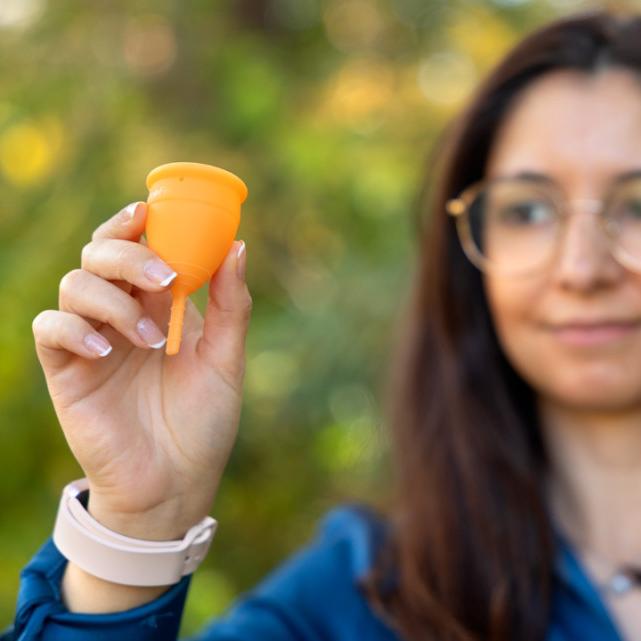A yearslong effort to launch Cornell-made satellite technology into a neighboring solar system is making a terrestrial stop at the Intrepid Sea, Air and Space Museum in New York City.
The new exhibit, “Postcards from Earth: Holograms on an Interstellar Journey,” which opened Feb. 16, showcases the project, in which a small, low-cost satellite – i.e., CubeSat – will be released into low Earth orbit and will deploy a “light sail” that is only 0.18 mm thick. This feat of aerospace engineering, which will demonstrate the potential of making the 40-trillion-mile trek to Alpha Centauri, will have an equally inventive stowaway: the CubeSat and the light sail will be adorned with holographic art.
Just as late Cornell astronomer Carl Sagan’s Voyager Golden Record sent thoughtfully curated artifacts of human culture into the cosmos, these holograms will deliver their own message of inspiration, with a distinctly local twist. The holograms feature sculptures created by Ithaca-born artist C Bangs around the theme of earthling DNA: a fish, a man, a woman and a moth.
“It’s representing our home, in a sense, these different forms of life that we’re sending out there, up into space,” said Gillis Lowry ’24, an astronomy major in the College of Arts and Sciences, who designed the exhibit in collaboration with museum staff and doctoral student Joshua Umansky-Castro, who heads up the Alpha CubeSat project for the Cornell Space Systems Design Studio. “We have our ChipSats and our little CubeSat model to demonstrate how we’re going to get to other star systems, but the main message of the exhibit is ‘What sort of message would you want to send to aliens?’”
The holograms were created in partnership with holographer Martina Mrongovius and the specific designs were selected by the Alpha CubeSat team, members of the public, and even beloved science advocate and Cornellian Bill Nye ’77 during a campus visit. Museumgoers can vote to pick the final hologram, which will either be a leopard or a sleeping cat.
While the Golden Record only had so much room, a single hologram can potentially hold thousands of images, making the technology an incredibly efficient means of interstellar communication. Holograms could also serve a practical function, helping to stabilize a future light sail, which would be propelled by a laser beam shined from Earth, on its way to another star system.
In the proof-of-concept demonstration, tentatively scheduled for January 2024, the sail will also be equipped with four computer chip-sized satellites, or “ChipSats,” to collect data about the voyage – such as its trajectory, kinematics and temperature – and broadcast it down to Earth. The sail was designed by Silicon Valley inventor and NASA consultant Andy Filo.
“It’s a half-meter-by-half-meter sail with extremely low mass to accelerate to really high velocities. To get something so low mass, that’s really where our tiny little ChipSats come in. And that’s something our lab specializes in,” said Umansky-Castro, who noted the effort is inspired by interstellar initiatives such as Breakthrough Starshot, which aims to fly nanocraft at 20% the speed of light and reach Alpha Centauri within 20 years of their launch. “No way are undergrads and grad students here solving all the problems it takes to get to Alpha Centauri. But this mission, Alpha CubeSat, is very much inspired by that larger goal.”
The Alpha CubeSat project is part of NASA’s CubeSat Launch Initiative and is overseen by Mason Peck, the Stephen J. Fujikawa ’77 Professor of Astronautical Engineering in Cornell Engineering, who directs the Space Systems Design Studio.
“Taking research with far-reaching implications, taking risks and pushing beyond the limits of today’s spacecraft – that’s what we do in academic research,” Peck said. “I’m proud that the students have embraced the audacious nature of this flight experiment, and I expect this foundation will help shape their careers in the years to come.”
The Alpha CubeSat team currently comprises about 35 students; more than 100 students have contributed since the project began in 2016.
“I’ve been in this windowless basement lab for the past four years, tinkering away, trying to get this CubeSat to work,” Umansky-Castro said. “So it is pretty surreal that it’s in the public spotlight now and we get to share this story with so many people.”
In designing the exhibit, Lowry faced the challenge of findings ways to articulate “hard-to-wrap-your-head-around concepts” that would connect with the general public. Instead of tinkering with solar cells and light sensors like Umansky-Castro, she tinkered with metaphors.
“If lightspeed itself is a jet, then our fastest spacecraft, so far, is an ant scuttling across the ground. But if we send out a light sail, that’s comparatively like a car on the Autobahn going over 100 miles an hour,” she said. “So I hope that this exhibit proves to people that, well, we don’t have this technology yet, but this is something that’s actually possible.”
The incorporation of holograms gives the project an interdisciplinary thrust by combining engineering and art, in a way that feels very true to Sagan’s vision.
“Carl Sagan is kind of the whole reason that I’m at Cornell. He’s been my biggest inspiration,” said Lowry, who shares a birthday with the astronomer. “I think Alpha CubeSat is another extension of how Cornell is continuing his legacy. And I really hope that a mission like this is something he would be proud of us for.”





